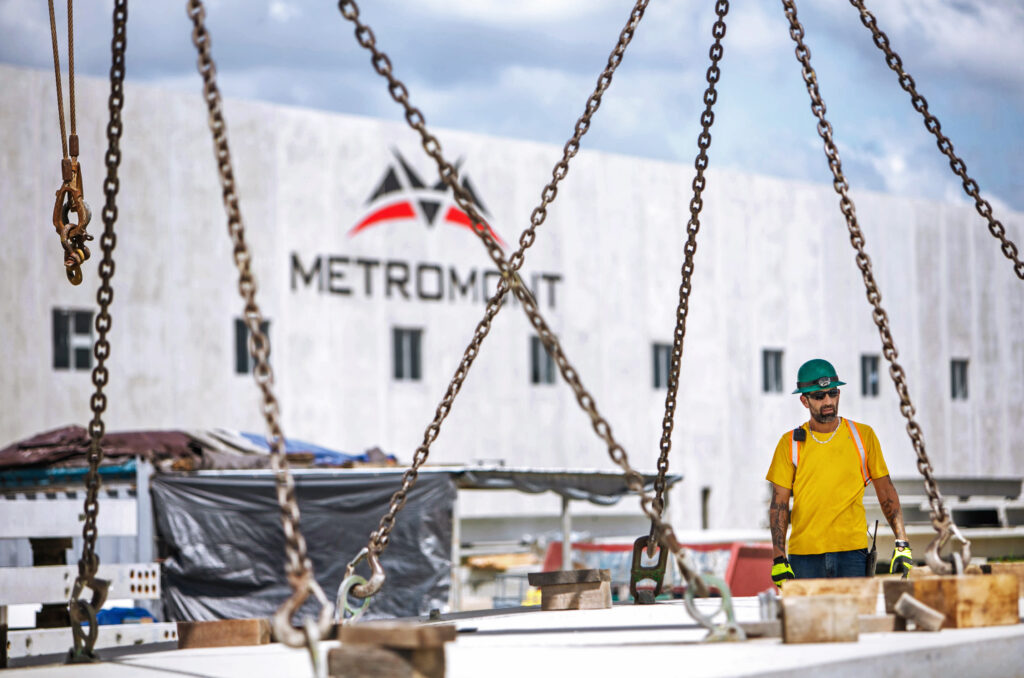
Sustainability is meeting the needs of the present generation without compromising the needs of future generations. In other words, sustainability is our capacity to endure. As an industry. As a society. And as a people. We do this by making the most of our resources and by recycling and reusing materials whenever possible in a responsible and efficient manner.
Every day, Americans utilize infrastructure to work, live, and go about their daily lives. It’s often overlooked unless you work in the materials industry. At Metromont, we’re up close and personal with how building materials impact people’s lives, accomplish goals, improve opportunities, and generally make the world a more connected place. Just look at some of our previous precast concrete projects involving schools, data centers, and sports and entertainment venues.
While our main focus is to provide quality precast concrete for a variety of uses, we also need to look at how our structures – and their production – impact the surrounding environment. Sustainability is a civic duty as a construction company, both in terms of how we produce our materials and how they stand the test of time. Producing sustainable concrete buildings and sustainable concrete structures is a huge aspect of Metromont’s business that keeps our customers and contractors coming back.
Concrete is a construction industry standard. In the past, it has been one of highest contributors to harmful environmental byproducts like carbon dioxide, namely due to its widespread use. But did you know that our precast, prestressed concrete materials are one of the most sustainable building materials out there?
Below are 5 unique ways utilizing Metromont’s precast concrete materials is sustainable for the environment and our customers.
1. Recycling Waste
Metromont is a leader in reducing construction waste through agressive reclamation and recycling of our construction materials. In your average building project, most of the waste comes from brick, concrete, and lumber which is wasted for a variety of reasons. There can be as much as 10 – 15% waste of building materials on any given construction project (typical rates are lower, but there’s a wide, wide range) and many of those materials simply get landfilled after they’re not used.
Metromont is dedicated to reclaiming and recycling materials that go into our sustainable concrete structures. By manufacturing concrete in controlled environments, we are able to minimize waste, noise, and dust, typically creating less than 2% waste and reclaiming approximately 95% of that waste for reuse. In one plant alone, we recycle approximately 6.3 million gallons of water per year.
2. Fly Ash Reclamation
The manufacturing of concrete itself can be a wasteful process. Cement, one of three core ingredients in concrete, is one of leading producers of carbon dioxide, sitting behind the transportation industry and the energy industry. Fly ash is the physical byproduct of creating cement from burning coal and often it is just captured and landfilled.
We offset the waste in our cement production by using reclaimed fly ash in our sustainable concrete buildings. We use it as a material in our concrete, often incorporating as much as 15% – 35% in most of our structural products.
3. Our Materials Last Longer
An additional benefit of reclaiming fly ash and using it in our products is that it actually makes our precast concrete products stronger. Concrete made using fly ash is called geopolymer concrete, or GPC.
According to a research study in Science Daily:
… geopolymer concrete (GPC) features greater corrosion resistance, substantially higher fire resistance (up to 2400° F), high compressive and tensile strengths, a rapid strength gain, and lower shrinkage. Perhaps Geopolymer concrete’s greatest appeal is its life cycle greenhouse gas reduction potential; as much as 90% when compared with OPC. (source)
4. Sourcing Locally
Much like the farm-to-table phenomenon in the food industry, Metromont is also reducing waste in sourcing our materials from local and regional material providers. In the regional markets we serve, typically 80-90% of the materials are extracted, manufactured, delivered and installed within 100 – 500 miles of all project sites. That greatly reduces the resources needed to transport materials thousands of miles from the production site to construction site.
5. Reduced Energy Costs for Our Consumers
The big picture with sustainability is to not only deliver quality products that don’t tax the environment to produce, but to provide our customers with a long lasting sustainable concrete structure that minimizes energy consumption. Our precast concrete structures store energy and dampen the effect of temperature change and the impact it has on heating and cooling systems. We build sustainably by looking at the energy savings over the entire lifetime of our products. If you’re building a multi-family residence, those savings could amount to millions of dollars over the lifetime of the structure by offering:
Long-term energy savings – less energy to heat or cool a structure
Smaller investment in HVAC equipment
Conclusion
Our buildings are sustainable in a lot of different ways for both consumers and the environment. From the way that we produce our precast concrete, to how we build them, we strive to ensure that we’re producing the highest quality structure with the least amount of waste and tax on the environment.
To learn more about our sustainability efforts, you can visit this page.




